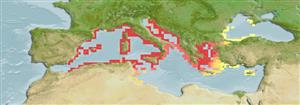>
Blenniiformes (Blennies) >
Blenniidae (Combtooth blennies) > Salariinae
Etymology: Parablennius: Greek, para = the side of + Greek, blennios = mucus (Ref. 45335).
Eponymy: Demetrius Zvonimir (d: 1089) was King of Croatia and Dalmatia. The blenny was first identified from the Dalmatian coast. However, as the original text does not give an etymology, this remains a ‘best guess’ identification. (Ref. 128868), visit book page.
Environment: milieu / climate zone / пределы глубины / distribution range
экология
морской демерсальный; пределы глубины 6 - 12 m (Ref. 80021). Subtropical; 47°N - 30°N, 6°W - 42°E
Mediterranean Sea and Black Sea.
Size / Вес / Возраст
половая зрелость: Lm ? range ? - ? cm
Max length : 7.0 cm TL самец/пол неопределен; (Ref. 5981)
Краткое описание
определительные ключи | морфология | морфометрия
колючие лучи спинного плавника (общее число) : 12; членистые (мягкие) лучи спинного плавника (общее число) : 18; колючие лучи анального плавника: 2; членистые (мягкие) лучи анального плавника: 19 - 20.
Body shape (shape guide): fusiform / normal.
Facultative air-breathing in the genus (Ref. 126274); Adults inhabit dimly lit biotopes like overhanging rocks or caves. Also found in piddock holes. They graze on periphyton (Ref. 5981). Oviparous. Eggs are demersal and adhesive (Ref. 205), and are attached to the substrate via a filamentous, adhesive pad or pedestal (Ref. 94114). Larvae are planktonic, often found in shallow, coastal waters (Ref. 94114).
Life cycle and mating behavior
половая зрелость | размножение | нерест | икра | Fecundity | личинки
Oviparous, distinct pairing (Ref. 205). Female deposit eggs inside an empty mussel, male tends the clutch (Ref. 47356). Courtship behavior entails males rearing up front of body (Ref. 5981). Yawning makes for a defense to drive away rivals (Ref. 5981).
Zander, C.D., 1986. Blenniidae. p. 1096-1112. In P.J.P. Whitehead, M.-L. Bauchot, J.-C. Hureau, J. Nielsen and E. Tortonese (eds.) Fishes of the North-eastern Atlantic and the Mediterranean, volume 3. UNESCO, Paris. (Ref. 5981)
Статус Красного Списка МСОП (Ref. 130435: Version 2025-1)
Угроза для людей
Harmless
Использование человеком
дополнительная информация
инструменты
Специальные отчеты
Скачать в формате XML
ресурсы в Интернет
Estimates based on models
Preferred temperature (ссылка
123201): 16.8 - 19.7, mean 18.8 °C (based on 351 cells).
Phylogenetic diversity index (ссылка
82804): PD
50 = 0.5000 [Uniqueness, from 0.5 = low to 2.0 = high].
Bayesian length-weight: a=0.01096 (0.00465 - 0.02585), b=2.99 (2.81 - 3.17), in cm total length, based on LWR estimates for this Genus-body shape (Ref.
93245).
Trophic level (ссылка
69278): 2.6 ±0.0 se; based on diet studies.
устойчивость к внешним воздействиям (ссылка
120179): высокий, минимальное время удвоения популяции до 15 месяцев (Preliminary K or Fecundity.).
Fishing Vulnerability (Ref.
59153): Low vulnerability (10 of 100).
🛈
Nutrients (Ref.
124155): Calcium = 339 [168, 752] mg/100g; Iron = 1.92 [1.14, 3.53] mg/100g; Protein = 18.5 [17.5, 19.5] %; Omega3 = 0.354 [0.195, 0.644] g/100g; Selenium = 14.1 [6.8, 30.0] μg/100g; VitaminA = 22.2 [6.9, 70.3] μg/100g; Zinc = 1.76 [1.17, 2.63] mg/100g (wet weight);
